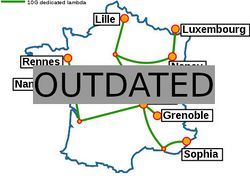Grid5000:Home: Difference between revisions
No edit summary |
No edit summary |
||
| Line 7: | Line 7: | ||
Key features: | Key features: | ||
* provides '''access to a large amount of resources''': | * provides '''access to a large amount of resources''': 12000 cores, 800 compute-nodes grouped in homogeneous clusters, and featuring various technologies: GPU, SSD, NVMe, 10G Ethernet, Infiniband, Omnipath | ||
* '''highly reconfigurable and controllable''': researchers can experiment with a fully customized software stack thanks to bare-metal deployment features, and can isolate their experiment at the networking layer | * '''highly reconfigurable and controllable''': researchers can experiment with a fully customized software stack thanks to bare-metal deployment features, and can isolate their experiment at the networking layer | ||
* '''advanced monitoring and measurement features for traces collection of networking and power consumption''', providing a deep understanding of experiments | * '''advanced monitoring and measurement features for traces collection of networking and power consumption''', providing a deep understanding of experiments | ||
Revision as of 08:23, 18 September 2018
|
Grid'5000 is a large-scale and versatile testbed for experiment-driven research in all areas of computer science, with a focus on parallel and distributed computing including Cloud, HPC and Big Data. Key features:
Older documents:
|
Random pick of publications
Five random publications that benefited from Grid'5000 (at least 2925 overall):
- Théophile Bastian, Hugo Pompougnac, Alban Dutilleul, Fabrice Rastello. CesASMe and Staticdeps: static detection of memory-carried dependencies for code analyzers. INRIA. 2024, pp.1-12. hal-04477227 view on HAL pdf
- Emmanuel Medernach, Gaël Vila, Axel Bonnet, Sorina Camarasu-Pop. ReproVIP Report #2.1.1 Application Deployment Strategies. CREATIS Université Lyon 1. 2024. hal-04551771 view on HAL pdf
- Guillaume Helbecque, Ezhilmathi Krishnasamy, Nouredine Melab, Pascal Bouvry. GPU-Accelerated Tree-Search in Chapel versus CUDA and HIP. 14th IEEE Workshop Parallel / Distributed Combinatorics and Optimization (PDCO 2024), May 2024, San Francisco, United States. 10.1109/IPDPSW63119.2024.00156. hal-04551856 view on HAL pdf
- Alix Jeannerot. Uplink Resource Allocation Methods for Next Generation Wireless Networks. Networking and Internet Architecture cs.NI. INSA lyon, 2024. English. NNT : . tel-04816916v2 view on HAL pdf
- Baptiste Jonglez, Matthieu Simonin, Jolan Philippe, Sidi Mohammed Kaddour. Multi-provider capabilities in EnOSlib: driving distributed system experiments on the edge-to-cloud continuum. DAIS 2025: 25th International Conference on Distributed Applications and Interoperable Systems, Jun 2025, Lille, France. pp.25-42, 10.1007/978-3-031-95728-4_2. hal-05052776 view on HAL pdf
Latest news
Failed to load RSS feed from https://www.grid5000.fr/mediawiki/index.php?title=News&action=feed&feed=atom: Error parsing XML for RSS
Grid'5000 sites
Current funding
As from June 2008, Inria is the main contributor to Grid'5000 funding.
INRIA |
CNRS |
UniversitiesUniversité Grenoble Alpes, Grenoble INP |
Regional councilsAquitaine |


